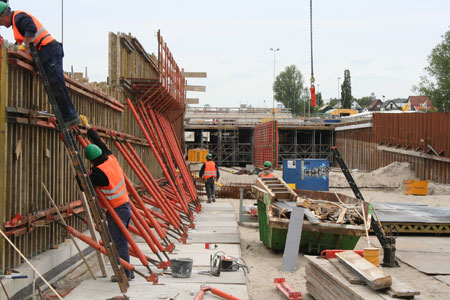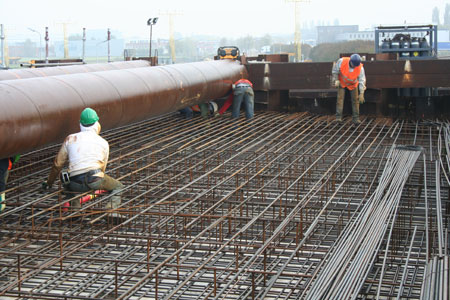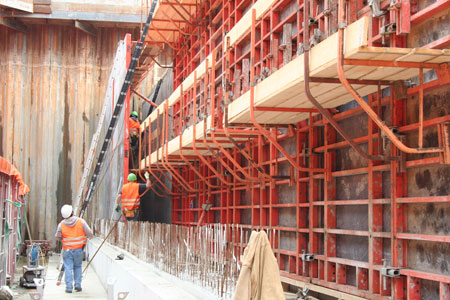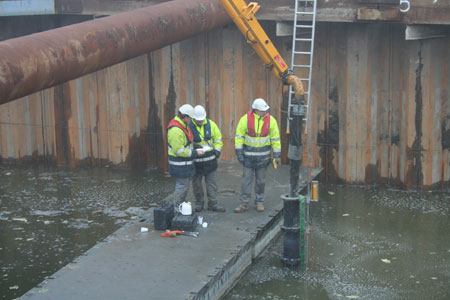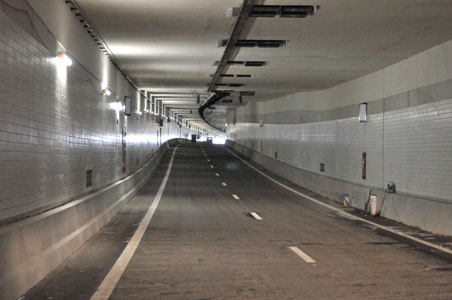Air traffic demands innovation near Schipol
Feb 2012
Armand van Wijck, TunnelTalk European Correspondent
-
The Waterwolf Tunnel, winner of the 2011 Dutch Concrete Awards, is currently in its finishing phase. The nearby location of Schiphol Airport led to an innovative design and execution of the tunnel construction that included the casting of reinforced underwater concrete on an inclined plane, believed to be a European first.
-

Waterwolf Tunnel is in its finishing phases
Photo by Bart Fens - The Waterwolf Tunnel is an important part of the Dutch N201 highway diversion between Aalsmeer and Uithoorn. Close to Schiphol Airport, the 1,450m long tunnel passes under the Haarlem ring canal and beneath the flight path of the Aalsmeer runway. "As a result, we had to deal with a hoist height limitation of 13m above ground level," said the Head of Construction, Foort Minnaard of the construction contractor JV Combination N201 comprising Heijmans and Boskalis. This presented a problem as the sheet piles supporting the cut-and-cover cofferdam construction across the canal were longer than the height limitation.
- "The moment the Aalsmeer runway was clear, we worked on installing the sheet piles with our hoist crane," said Minnaard. "There were days that we could work two hours a day, and sometimes none at all."
- Following installation, the sheet piles remained in place and became part of the design and construction itself. The tunnel floor slab and roof deck are attached to the sheet piles with an annulus between them and the concrete walls. As Minnaard explained: "The sheet piles continue to hold the ground pressure with the tunnel walls withstanding only the water pressure. As a result the thickness of the tunnel walls have been reduced to 40cm thick."
Formwork and reinforcement installation for the cut-and-cover construction within the permanent sheet piles
-
Reinforced underwater concrete
Retaining the sheet piles led to additional innovation. Normally, the base slab of a cut-and-cover water crossing is supported on anchor piles to resist buoyancy. This was no longer necessary, according to Minnaard, thanks to reinforced underwater concrete that is connected to the sheet piles. "Connecting the base slab to the sheet piles eliminated the need for the support piles. An additional advantage is that we have been able to put the road foundation and the asphalt right on top of the underwater concrete floor. We saved having to use a construction floor and the many filler layers that are needed when using such a construct. This saved us 3m on the depth of the cut-and-cover trench which saved also on construction time."
-

Reinforcement for the roof deck
- The design did mean however, that the JV had to deposit the underwater concrete on a 4% slope which is believed to be the first time for the technique in Europe. The composition of the concrete was critical to success. The mix was not allowed to run, but could not be too stiff either. If it lost its self-compacting function the floor slab would never be watertight.
- "To meet the criteria," explained Minnaard, "we created mixes for different parts of the floor, each mix having a different slump. For the level floor, a slump of 600mm was used while on the 4% transition gradients of the tunnel, the slump was adjusted to 500mm." With these compositions, 11,000m3 underwater concrete was cast at a pour rate of about 100m3 per hour.
- The primary construction phase, supported by the sheet piles and including the cofferdam across the canal, was then pumped dry and the walls and the roof of the tunnel cast using travelling forms and ordinary concrete. "After casting the walls, we advanced the reinforcement and concreting of the roof," said Minnaard, "and advanced about 25m a week using the system."
- Innovations associated with the design and construction of the Waterwolf road tunnel earned for the designers and constructors the 2011 Dutch Concrete Award.
|
|
|
|
|
Add your comment
- Thank you for taking the time to share your thoughts and comments. You share in the wider tunnelling community, so please keep your comments smart and civil. Don't attack other readers personally, and keep your language professional.


